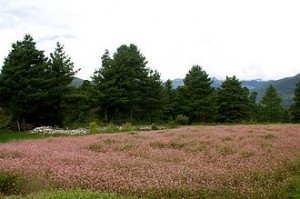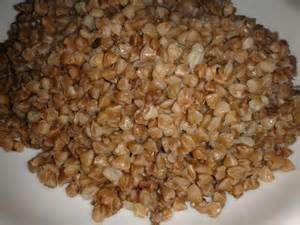As I’ve written elsewhere, what daffodils were to V.S. Naipaul, frangipanis were to me: As a child, while reading ‘The Mutiny on the Bounty’ I’d been fascinated by the word ‘frangipani’ which seemed to me to be redolent of all that was mysterious, desirable and secret. Then one day I discovered that the gnarled old branches by my window belonged to none other than a ‘frangipani’ tree…
My list of frangipani moments grew a little longer three months ago, in Kolkata, when a friend handed me a packet of what she said was buckwheat flour, bought at a bazar around the corner. Till then I had thought of buckwheat as a rare and exotic substance, encountered primarily as the silken noodles the Japanese call soba: great was my astonishment when I discovered that it is actually none other than the food known as kottu in much of India!
Despite its name buckwheat is not a grain;

it is the seed of a finely-scented flowering plant (the flowers are said to produce excellent honey).
The virtues of buckwheat are legion: not only is it gluten-free and exceptionally nutritious, it has a very short growing season and flourishes in difficult conditions (in fact it does badly on fertile soils). It is also intrisically resistant to efforts at ‘improvement’ because it cross-pollinates naturally: in other words, buckwheat is Nature’s way of sticking a finger in Monsanto’s eye.

Buckwheat is a shape-shifter, with a wonderful ability to adapt itself to different tastes. Thus in Japan it assumes the guise of an actor upon the almost-empty stage of a Noh play;

the austere but refined aestheticism of that culinary culture turns it into strands of exquisite delicacy, to be savoured almost without any flavourings.
In the Indian subcontinent, by contrast, buckwheat takes on the avatar of a dancer in a Bollywood item number, strutting, leaping, dancing, jiggling, flirting.
A mathematician of my acquaintance, Harpreet Singh, has a theory that India is a ‘fractal culture’. Last year (in a letter that is posted on my blog) he wrote:
a form has a fractal geometry, or is a fractal, if the form repeats itself infinitely upon magnification… When I say that I think the Indian aesthetic is fractal in nature I am not referring to this repeatability upon magnification but simply to the presence of details upon details that exhibit themselves as you pull in closer. The Indian psyche would not have been happy with a straight edge temple, which is very different from the Greeks or the Egyptians for example. It was felt necessary to add details upon detail in the smallest of spaces. Compare this with the Parthenon in Greece where the straight edge observed from afar is a true straight edge of a pillar or the roof… I see traces of this Indian need/appreciation for complexity in their music, with notes between notes, and in Indian cuisine where the interplay of many different flavors is not just the strength but also the defining characteristic of the cuisine.
Recently he developed this theme in another letter:
If you recall, about a year ago I shared my theories of the fractal nature of India’s art and how the Indian need/appreciation for complexity also appears in Indian music, and Indian cuisine. The complexity and uniqueness of Indian cuisine was highlighted by a research paper from IIT Jodhpur, that has been heavily referenced this week in social and commercial media.
In a nutshell, the flavor of a food or a spice is determined by specific chemical components of the food that receptors in our tongue, mouth and nose respond to. The more two foods share these “flavor” chemical components the more we say they are positively paired or correlated. If two foods share very few of these flavor chemicals then we say they are negatively paired.
Most western cuisine involves a few ingredients with very strong positive pairing. A good analogy is fashion. Western fashion involves matching a few similar or compatible colors. Indian cuisine however (like Indian fashion) involves a riot of ingredients with little flavor correlation. It is actually a sign of Indian genius that the specific negative pairings that make up an Indian recipe are made to work as well as they do by the inclusion of spices (accessories)! The point isn’t just that Indians can make this complexity work but that they wouldn’t have it any other way. A simple pairing of just wine and cheese just doesn’t satisfy the Indian need for complexity, a characteristic that I am loosely calling fractal because of how it manifests itself in Indian art.
The research paper referenced above draws much of its data from a source that offers many excellent buckwheat recipes (more are to be found here and here).
While experimenting with buckwheat rotis, dosas, uppma etc. I chanced upon something unexpected: buckwheat flour makes a great crust for pies and quiches. When baked it becomes very crisp and stays so no matter how moist the filling. A buckwheat crust also requires very little effort because it doesn’t need to be rolled out: it can be pressed gently into place with one’s fingers. This site has a recipe for the dough.
Compelled by the fractal nature of my own tastes I’ve tried adding garam masala, chili powder and ras al hanout to the dough, and have found that they all work very well. Others still more fractal than I, might want to try adding all of these together and a dash of Sriracha sauce too. Why not? After all in some culinary traditions more is better.

Thanks Amitav, a delightful read and full of so many fractal details!
Firangipani is known as ‘champa’ in India. strange, because firangipani itself sounds like such an Indian name. also called ‘gulchini’ in some places.